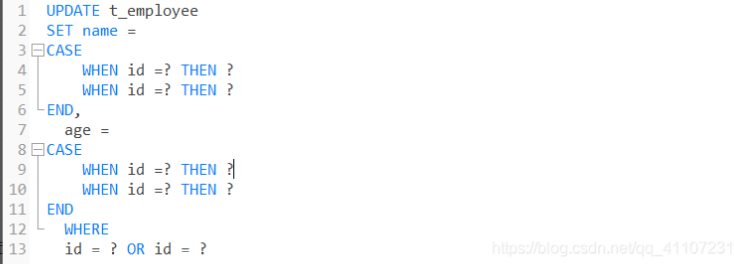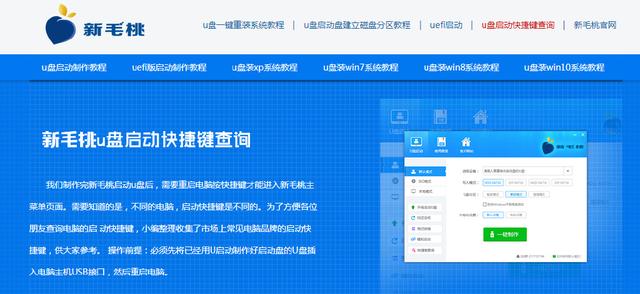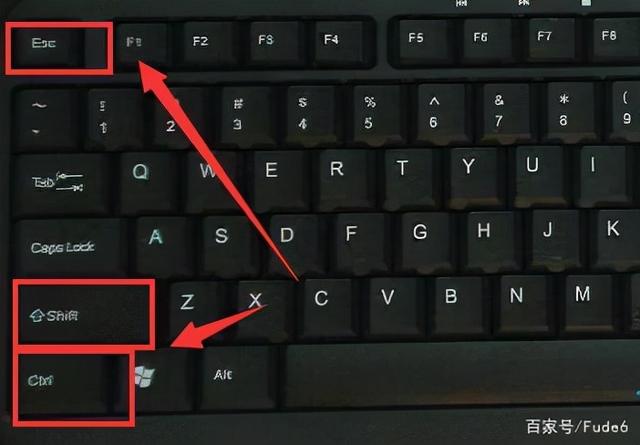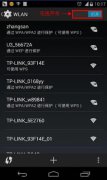前言
工作中,经常会遇到很多批量操作的需求:批量添加、批量更新、批量删除、批量导入、批量审核等等,下面这篇文章我们将一一复现,首先我们先了解一下mybatis的标签foreach循环:
一、MybatIs标签foreach
foreach的主要用在构建in条件中,它可以在SQL语句中进行迭代一个集合。
foreach元素的属性主要有 item,index,collection,open,separator,close。
1》item集合中每一个元素进行迭代时的别名
2》index表示在迭代过程中,每次迭代到的位置
3》open该语句以什么开始
4》separator在每次进行迭代之间以什么符号作为分隔符
5》close以什么结束
1.collection属性主要有一下3种情况:
1.1 如果传入的是单参数且参数类型是一个List的时候,collection属性值为list
1.2 如果传入的是单参数且参数类型是一个array数组的时候,collection的属性值为array
1.3 如果传入的参数是多个的时候,我们就需要把它们封装成一个Map了
二、批量添加
当传入参数是list集合的时候:
2.1 Mapper.xml
<!--批量插入员工数据-->
<insert id="saveEmp" parameterType="java.util.List">
INSERT INTO t_employee(id, name, age, salary, department_id,update_time)
VALUES
<foreach collection="list" item="item" index="index" separator=",">
(#{item.id},#{item.name},#{item.age},#{item.salary},#{item.departmentId},now())
</foreach>
</insert>
2.2 Controller层
@PostMapping("saveBath")
@ResponseBody
public CommonResult<Employee> saveBath(@RequestBody List<Employee> employeeList){
return employeeService.saveEmp(employeeList);
}
@ResponseBody:返回Json数据 @RequestBody:接受Json数据
2.3 Json数组集合数据
[
{
"id": 1,
"name": "DT测试1",
"age": 26,
"salary": 10000.0,
"departmentId": 1
},
{
"id": 2,
"name": "DT测试2",
"age": 26,
"salary": 10000.0,
"departmentId": 2
}
]
三、批量更新
1.Mapper.xml
1.1 批量更新第一种方法
<update id="updateBatch" parameterType="java.util.List" >
<foreach collection="list" item="item" index="index" separator=";">
UPDATE t_employee
<set>
<if test="item.name != null and item.name != ''" >
name = #{item.name},
</if>
<if test="item.age != null" >
age = #{item.age},
</if>
<if test="item.salary != null" >
salary = #{item.salary},
</if>
<if test="item.salary != null" >
salary = #{item.departmentId},
</if>
</set>
where id = #{item.id}
</foreach>
</update>
记得连接数据库加:
allowMultiQueries=true
不然会报如下错误:
You have an error in your SQL syntax; check the manual that corresponds to your MySQL server version for the right syntax to use near 'UPDATE t_employee
MySQL连接数据库时,添加语句:“allowMultiQueries=true”的作用:
1.可以在sql语句后携带分号,实现多语句执行。 2.可以执行批处理,同时发出多个SQL语句。
这种方式就是通过SQL拼接,单条单条地进行更新。
1.2 批量更新第二种方法
<update id="updateBatch" parameterType="java.util.List" >
update t_employee
<trim prefix="set" suffixOverrides=",">
<trim prefix="name=case" suffix="end,">
<foreach collection="list" item="i" index="index">
<if test="i.name != null and i.name != ''">
when id=#{i.id} then #{i.name}
</if>
</foreach>
</trim>
<trim prefix="age=case" suffix="end,">
<foreach collection="list" item="i" index="index">
<if test="i.age != null">
when id=#{i.id} then #{i.age}
</if>
</foreach>
</trim>
</trim>
where
<foreach collection="list" separator="or" item="i" index="index" >
id = #{i.id}
</foreach>
</update>
实际上是通过case when语句进行批量更新,只要一条SQL语句:

当然除了上面两种方式外,还可通过如下:
批量更新第三种方法,用ON DUPLICATE KEY UPDATE,就是一个批量插入操作,在插入的时候,如果已存在,则更新,所以可以变相达到批量修改的效果。
一般不推荐这种更新大数据量的SQL,关于这种方式小编前面的文章也有说过使用方式,这里不再赘述。
注意:上面的方式是针对多个字段的情况,如果只是更新单个字段,可以这么写:
<!-- 批量更新第二种方法,针对单个字段进行批量更新 -->
<update id="updateBatch" parameterType="java.util.List">
UPDATE t_employee
SET name = CASE
<foreach collection="list" item="item" index="index">
WHEN id = #{item.id} THEN #{item.name}
</foreach>
END
WHERE id IN
<foreach collection="list" index="index" item="item" open="(" separator="," close=")">
#{item.id}
</foreach>
</update>
2.Controller层
@PostMapping("updateBatch")
@ResponseBody
public CommonResult<Employee> updateBatch(@RequestBody List<Employee> employeeList){
return employeeService.updateBatch(employeeList);
}
3.Json集合数据
[
{
"id": 1,
"name": "DT测试111",
"age": 2611
},
{
"id": 2,
"name": "DT测试211",
"age": 2611
}
]
四、批量删除
1. 传入的是List数组对象
1.Mapper.xml
<delete id="deleteBath" parameterType="java.util.List">
DELETE FROM t_employee WHERE id IN
<foreach collection="list" item="item" open="(" separator="," close=")">
#{item.id}
</foreach>
</delete>
2.Controller层
@PostMapping("deleteBath")
@ResponseBody
public CommonResult<Employee> deleteBath(@RequestBody List<Employee> employeeList){
return employeeService.deleteBath(employeeList);
}
3.Json集合数据
[
{
"id": 1
},
{
"id": 2
}
]
2. 传入的是数组
1.Mapper.xml
<delete id="deleteBath" parameterType="java.util.Arrays">
DELETE FROM t_employee WHERE id IN
<foreach collection="array" item="ids" open="(" separator="," close=")">
#{ids}
</foreach>
</delete>
2.Controller层
@PostMapping("deleteBath")
@ResponseBody
public CommonResult<Employee> deleteBath(@RequestBody int[] ids){
return employeeService.deleteBath(ids);
}
3.Json数组
[1,2]
2. 传入的是Map集合
1.Mapper.xml
<delete id="deleteBath" parameterType="java.util.Map">
DELETE FROM t_employee WHERE id IN
<foreach collection="ids" item="item" open="(" separator="," close=")">
#{item}
</foreach>
</delete>
int deleteBath(@Param("ids") Map<String, Integer> ids);
2.Controller层
@PostMapping("deleteBath")
@ResponseBody
public CommonResult<Employee> deleteBath(@RequestBody Map<String,Object> map){
// 接收List
List<Integer> ids = (List<Integer>) map.get("ids");
Map<String, Integer> stringMap = new HashMap<>();
ids.forEach(id -> stringMap.put("ids", id));
return employeeService.deleteBath(stringMap);
}
3.map数据
{
"ids": [1,2]
}
五、批量查询
1.Mapper.xml
<select id="findBath" resultType="com.dt.springbootdemo.entity.Employee" parameterType="com.dt.springbootdemo.entity.Employee">
SELECT * FROM t_employee WHERE id IN
<foreach collection="list" item="item" open="(" separator="," close=")">
#{item.id}
</foreach>
</select>
2.Controller层
@GetMapping("findBath")
@ResponseBody
public CommonResult<List<Employee>> findBath(@RequestBody List<Employee> employeeList){
return employeeService.findBath(employeeList);
}
3.Json集合数据
[
{
"id": 1
},
{
"id": 2
}
]
至于其它的数据格式就不再赘述了,很简单,变一下数据格式就可以了:






